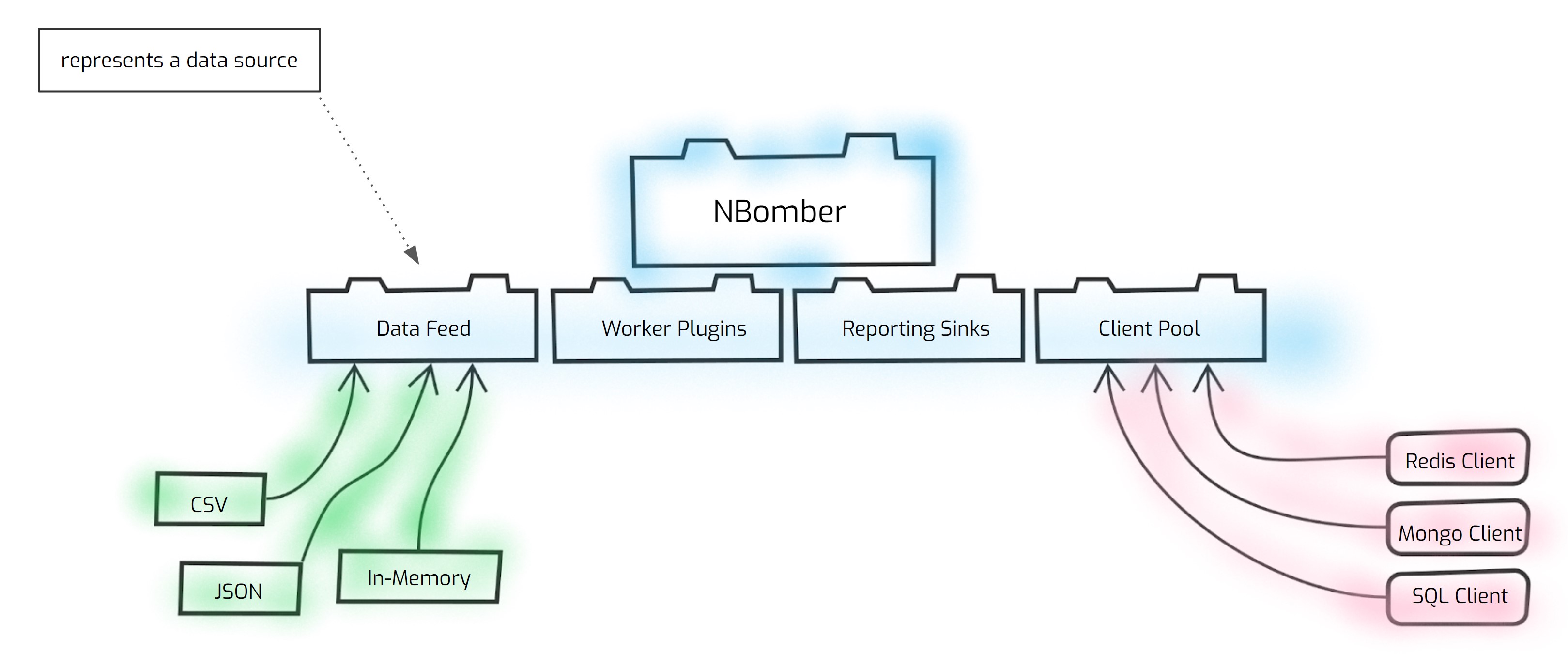Data

The NBomber.Data plugin provides functionality for NBomber to work with data. It helps you generate random bytes or use DataFeed abstraction to feed data into your load test scenario.
To install NBomber.Data package you should execute the following dotnet command:
dotnet add package NBomber.Data
DataFeed
DataFeed helps inject test data into your load test. Conceptually, it represents a data stream that can be used inside NBomber scenarios. It is defined via the following interface:
public interface IDataFeed<T>
{
T[] Items { get; }
T GetNextItem(ScenarioInfo scenarioInfo);
}
To create a DataFeed you need to provide data. The source can be any type that implements IEnumerable<T>, for example array of int[] or List<User>. Currently NBomber.Data provides three different DataFeed types. Each of them should be used based on your requirements.
// Creates DataFeed that randomly picks an item per `DataFeed.GetNextItem()` invocation.
DataFeed.Random(IEnumerable<T> data);
// Creates DataFeed that picks constant value per Scenario copy.
// Every Scenario copy will have unique constant value.
DataFeed.Constant(IEnumerable<T> data);
// Creates DataFeed that goes back to the top of the sequence once the end is reached.
DataFeed.Circular(IEnumerable<T> data);
Random DataFeed
DataFeed with random values.
var id = new[] { 10, 11, 12, 13, 14 };
// here we create Random DataFeed
// that randomly picks an item per GetNextItem() invocation.
var myDataFeed = DataFeed.Random(users);
var scenario = Scenario.Create("scenario", async ctx =>
{
// then in Scenario you can get RANDOM values from the DataFeed
var number = myDataFeed.GetNextItem(ctx.ScenarioInfo); // 10
number = myDataFeed.GetNextItem(ctx.ScenarioInfo); // 10
number = myDataFeed.GetNextItem(ctx.ScenarioInfo); // 14
number = myDataFeed.GetNextItem(ctx.ScenarioInfo); // 13
number = myDataFeed.GetNextItem(ctx.ScenarioInfo); // 11
number = myDataFeed.GetNextItem(ctx.ScenarioInfo); // 12
return Response.Ok();
})
Circular DataFeed
DataFeed with circular/sequential values.
var id = new[] { 10, 11, 12, 13, 14 };
// here we create Circular DataFeed
// that goes back to the top of the sequence once the end is reached.
var myDataFeed = DataFeed.Circular(users);
var scenario = Scenario.Create("scenario", async ctx =>
{
// then in Scenario you can get SEQUENTIAL values from the DataFeed
var number = myDataFeed.GetNextItem(ctx.ScenarioInfo); // 10
number = myDataFeed.GetNextItem(ctx.ScenarioInfo); // 11
number = myDataFeed.GetNextItem(ctx.ScenarioInfo); // 12
number = myDataFeed.GetNextItem(ctx.ScenarioInfo); // 13
number = myDataFeed.GetNextItem(ctx.ScenarioInfo); // 14
// we reached the end of the stream and restart iteration
number = myDataFeed.GetNextItem(ctx.ScenarioInfo); // 10
number = myDataFeed.GetNextItem(ctx.ScenarioInfo); // 11
number = myDataFeed.GetNextItem(ctx.ScenarioInfo); // 12
number = myDataFeed.GetNextItem(ctx.ScenarioInfo); // 13
number = myDataFeed.GetNextItem(ctx.ScenarioInfo); // 14
return Response.Ok();
})
Constant DataFeed
DataFeed with constant values per ScenarioCopy instance. This DataFeed type is usually used to get a unique distributed value per ScenarioCopy instance.
var id = new[] { 10, 11, 12, 13, 14 };
// here we create Constant DataFeed
// that picks constant value per Scenario copy.
// Every Scenario copy will have unique constant value.
var myDataFeed = DataFeed.Constant(users);
var scenario = Scenario.Create("scenario", async ctx =>
{
// then in Scenario you can get the constant value
// that relates to specific ScenarioCopy instance
// since we configured `Simulation.KeepConstant(copies: 1)`
// the returned value will be always the same for specific ScenarioCopy instance
var number = myDataFeed.GetNextItem(ctx.ScenarioInfo); // 12
number = myDataFeed.GetNextItem(ctx.ScenarioInfo); // 12
number = myDataFeed.GetNextItem(ctx.ScenarioInfo); // 12
number = myDataFeed.GetNextItem(ctx.ScenarioInfo); // 12
number = myDataFeed.GetNextItem(ctx.ScenarioInfo); // 12
return Response.Ok();
})
.WithLoadSimulations(
Simulation.KeepConstant(copies: 1, during: TimeSpan.FromSeconds(30)) // here we run only one ScenarioCopy
);
Read data from JSON
NBomber.Data provides extensions to read data from local or remote JSON file.
public class User
{
public int Id { get; set; }
public string Name { get; set; }
}
// load from local JSON file
var users = Data.LoadJson<User[]>("data.json");
// load from remote JSON file
var users = Data.LoadJson<User[]>("https://YOUR_HOST/data.json");
// now we can create DataFeed from `users: IEnumerable<User>`
var myDataFeed = DataFeed.Constant(users);
You can find the complete example by this link.
Read data from CSV
NBomber.Data provides extensions to read data from local or remote CSV file.
public class User
{
public int Id { get; set; }
public string Name { get; set; }
}
// load from local JSON file
var users = Data.LoadCsv<User>("data.csv");
// load from remote JSON file
var users = Data.LoadCsv<User>("https://YOUR_HOST/data.csv");
// now we can create DataFeed from `users: IEnumerable<User>`
var myDataFeed = DataFeed.Constant(users);
You can find the complete example by this link.
Generate random bytes
Generates an array with random bytes. This method is helpful when you want to test some system (over TCP/etc.) and for this, you need to send a message with a concrete size (for example, 4KB).
public static byte[] GenerateRandomBytes(int sizeInBytes)
Example:
var data = Data.GenerateRandomBytes(100);
Generate fake data
To generate fake data for your tests, we highly recommend looking at Bogus fake data generator. It's a popular library that contains useful methods for generating data.
Example:
public class FakeUser
{
public int Id { get; set; }
public string FirstName { get; set; }
public string LastName { get; set; }
public string Address { get; set; }
}
public class FakeDataGenExample
{
private IDataFeed<FakeUser> _usersFeed;
public void Run()
{
var scenario = Scenario.Create("scenario", async ctx =>
{
var user = _usersFeed.GetNextItem(ctx.ScenarioInfo);
await Task.Delay(1_000);
ctx.Logger.Information($"ScenarioCopyId: {ctx.ScenarioInfo.ThreadNumber}, UserId: {user.Id}");
return Response.Ok();
})
.WithInit(ctx =>
{
// we create 5 users and our Simulation.KeepConstant(copies: 5)
var users = GenerateFakeUsers(5).ToArray();
_usersFeed = DataFeed.Constant(users);
return Task.CompletedTask;
})
.WithLoadSimulations(Simulation.KeepConstant(copies: 5, during: TimeSpan.FromSeconds(30)));
NBomberRunner
.RegisterScenarios(scenario)
.Run();
}
private IEnumerable<FakeUser> GenerateFakeUsers(int count)
{
var faker = new Faker<FakeUser>()
.RuleFor(u => u.Id, f => f.UniqueIndex)
.RuleFor(u => u.FirstName, f => f.Person.FirstName)
.RuleFor(u => u.LastName, f => f.Person.LastName)
.RuleFor(u => u.Address, f => f.Address.FullAddress());
return faker.GenerateLazy(count);
}
}
You can find the complete example by this link.

